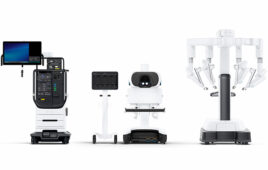|
Listen to this article
|
Editor’s Note: This article was syndicated from The Robot Report’s sister site Medical Design & Outsourcing.
The veil is starting to lift on medical robotics startup Mendaera Inc. as it exits stealth mode and heads toward regulatory submission with a design freeze on its first system and verification and validation imminent.
Two former Auris Health leaders co-founded the San Mateo, Calif.-based company. Mendaera also has financial support from Dr. Fred Moll, the Auris and Intuitive Surgical co-founder who is known as “the father of robotic surgery.”
“Among the innovators in the field, Mendaera’s efforts to make robotics commonplace earlier in the healthcare continuum are unique and can potentially change the future of care delivery,” stated Moll in a release.
But Mendaera isn’t a surgical robotics developer. Instead, it said it is working on technology that combines robotics, artificial intelligence, and real-time imaging in a compact device “no bigger than your fist” for procedures including percutaneous instruments.
Josh DeFonzo, co-founder and CEO of Mendaera, offered new details about his startup’s technology and goals in an exclusive interview, as he announced the acquisition of operating room telepresence technology that Avail Medsystems developed.
Avail, which shut down last year, was founded by former Intuitive Surgical and Shockwave Medical leader Daniel Hawkins, who’s now CEO at MRI automation software startup Vista.ai.
“We’re a very different form factor of robot that focuses on what I’ll describe as gateway procedures,” DeFonzo said. “It’s a different category of robots that we don’t believe the market has seen before [as] we’re designing and developing it.”
Those procedures include vascular access for delivery of devices or therapeutic agents; access to organs for surgical or diagnostics purposes; and pain management procedures such as regional anesthesia, neuraxial blocks, and chronic pain management. DeFonzo declined to go into much detail about specific procedures because the product is still in the development stage.
“The procedures that we are going after are those procedures that involve essentially a needle or a needle-like device and real-time imaging, and as such, there are specific procedures that we think the technology will perform very well at,” he said. “However, the technology is also designed to be able to address any suite of procedures that use those two common denominators: real-time imaging and a percutaneous instrument.”
“And the reason that’s an important point to make is that oftentimes, when you are a specialist who performs these procedures, you don’t perform just one,” added DeFonzo. “You perform a number of procedures: central venous catheters [CVCs], peripherally inserted central catheter [PICC] lines, regional anesthetic blocks that are in the interscalene area or axial blocks. The technology is really designed to enable specialists — of whom there are many — the ability to perform these procedures more consistently with a dramatically lower learning curve.”
 Learn from Agility Robotics, Amazon, Disney, Teradyne and many more.
Learn from Agility Robotics, Amazon, Disney, Teradyne and many more.
Mendaera marks progress to date
Preclinical testing has shown the technology has improved accuracy and efficiency in comparison with freehand techniques, regardless of the individual’s skill level, asserted DeFonzo. User research spanned around 1,000 different healthcare providers ranging from emergency medicine and interventional radiology to licensed medical doctors, nurse practitioners, and physician’s assistants.
“It seems to be very stable across user types,” he said. “So whether somebody is a novice, of intermediate skill level, or advanced, the robot is a great leveler in terms of being able to provide consistent outcomes.”
“Whereas when you look at the same techniques performed freehand, the data generally tracks with what you would expect: lesser skilled people are less accurate; more experienced people are more accurate,” DeFonzo noted. “But even in that most skilled category, we do find that the robot makes a fairly remarkable improvement on accuracy and timeliness of intervention.”
Last year, the startup expanded into a production facility to accommodate growth and volume manufacturing for the product’s launch and said its system will be powered by handheld ultrasound developer Butterfly Network’s Ultrasound-on-Chip technology.

Butterfly Network won FDA clearance in 2017 for the Butterfly iQ for iPhone. | Source: Butterfly Network
Mendaera’s aim is to eventually deploy these systems “to the absolute edge of healthcare,” starting with hospitals, ambulatory surgical centers and other procedural settings, said DeFonzo. The company will then push to alternative care sites and primary care clinics as evidence builds to support the technology.
“The entire mission for the company is to ensure essentially that high-quality intervention is afforded to every patient at every care center at every encounter,” he said. “We want to be able to push that as far to the edge of healthcare as possible, and that’s certainly something we aim to do over time, but it’s not our starting point explicitly.”
“As a practical starting point, however, we do see ourselves working in the operating room, in the interventional radiology suite, and likely in cath labs to facilitate these gateway procedures, the access that is afforded adjacent to a larger intervention,” DeFonzo acknowledged.
Mendaera said it expects to submit its system to the U.S. Food and Drug Administration for review through the 510(k) pathway by the end of 2024 with the goal of offering the product clinically in 2025.
“What we really want to do with this technology is make sure that we’re leveraging not just technological trends, but really important forces in the space — robotics, imaging and AI — to dramatically improve access to care,” said DeFonzo. “Whether you’re talking about something as basic as a vascular access procedure or something as complex as transplant surgery or neurosurgery, we need to leverage technology to improve patient experience.”
“We need to leverage technology to help hospitals become more financially sustainable, ultimately improving the healthcare system as we do it,” he said. “So our vision was to utilize technology to provide solutions that aggregate across many millions, if not tens and hundreds of millions, of procedures to make a ubiquitous technology that really helps benefit our healthcare system.”
Mendaera’s research and development group will work with employees from Avail on how to best add the telepresence technology to the mix.
“We see a lot of power in what the Avail team has built,” DeFonzo said. “Bringing that alongside robotic technology, our imaging partnerships and AI, we think that we’ve got a really good opportunity to digitize to a further extent not only expertise in the form of the robot, but [also] clinical judgment, like how do you ensure that the right clinician and his or her input is present ahead of technologies like artificial intelligence that hopefully augment all users in an even more scalable way.”








Tell Us What You Think!